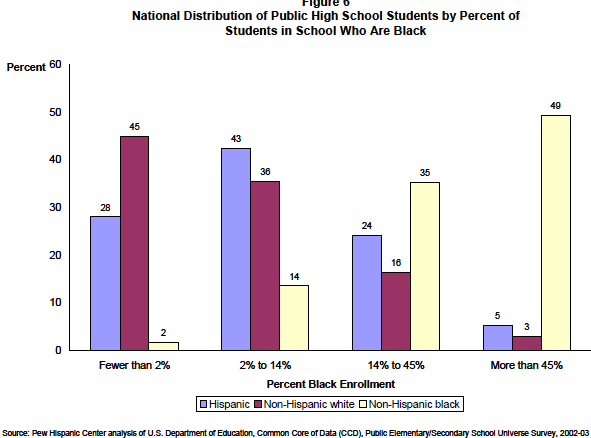One explanation for why Hispanic youths attend different kinds of high schools than other youths stems from their geographic concentration in certain states. Hispanics tend to be educated in public high schools in different states than the public high schools that educate whites and blacks. Table 2 reports the distribution of Hispanic, white and black public high schools students in seven states—California, Texas, Florida, New York, Arizona, Illinois and New Jersey—and in the rest of the United States. These seven states have relatively large Hispanic public high school enrollments. Public high schools in these seven states educate almost 80 percent of the nation’s 2 million Hispanic public high school students; high schools in California and Texas alone educate more than 55 percent of them. White and black youths are less likely to be educated at high schools in those states. High schools in the seven states with large Hispanic enrollment educate fewer than one third of the nation’s white and black youths.



Geographic concentration matters because public high schools in the seven large Hispanic states tend to have different characteristics than public high schools in other states. Public high schools in the seven large Hispanic states tend to be larger, have greater concentration of less affluent students and have higher student to teacher ratios than public high schools elsewhere. Because proportionally more Hispanics than whites or blacks are educated in these seven states, there is an automatic tendency for Latino students to be enrolled in large, more disadvantaged schools with greater student to teacher ratios.
Nationally, the average public high school enrolled 754 students in school year 2002-03 (Table 1). Public high schools in the seven states on average enroll more than 754 students (Table 3). Arizona is the only large Hispanic-enrollment state that has public high schools with average enrollment below 754 students (they average 651 students).
Similarly, the type of community in which public high schools are located is fairly uniform within the seven large Hispanic enrollment states. Their public high schools are considerably more likely to be in the central city than is the case for high schools in the other 43 states and the District of Colombia. The percentage of public high schools located in the central city ranges from 18.3 percent in Illinois to 44.6 percent in Arizona (Table 3). Outside the seven large Hispanic states, 16 percent of public high schools are located in central cities.
As for minority enrollment, in each of the seven large Hispanic states public high schools on average have student bodies made up of more minorities than is the case for high schools elsewhere in the United States. Public high schools elsewhere average 23.2 percent minority enrollment among their student bodies. That compares with 57.6% of the student body in California, 49.6% in Texas, 43.2% in Florida, 35.1% in New York, 50.6% in Arizona, 27.2% in Illinois and 36.7% in New Jersey.
So, public high schools in the seven states tend to be larger, are more likely to be located in the central city and have greater minority enrollment on a percentage basis than public high schools elsewhere.
Public high schools in the seven states do not uniformly educate more students who qualify for free or reduced-price lunches. On average, public high schools nationwide have 31.9 percent of their students eligible for this program (Table 1). Public high schools in California and Texas, on average, have 35.7 percent and 38.9 percent student eligibility. Thus, public high schools in these two key Hispanic states tend to have more economically disadvantaged students.
Finally, turning to the student-to-teacher ratio, public high schools in some of the seven large Hispanic states have average ratios that are greater than the national high school average. Nationally, public high schools average 16.1 students per teacher (Table 1). Public high schools in California, Florida and Arizona have an average ratio greater than 16.1 students per teacher (Table 3).


